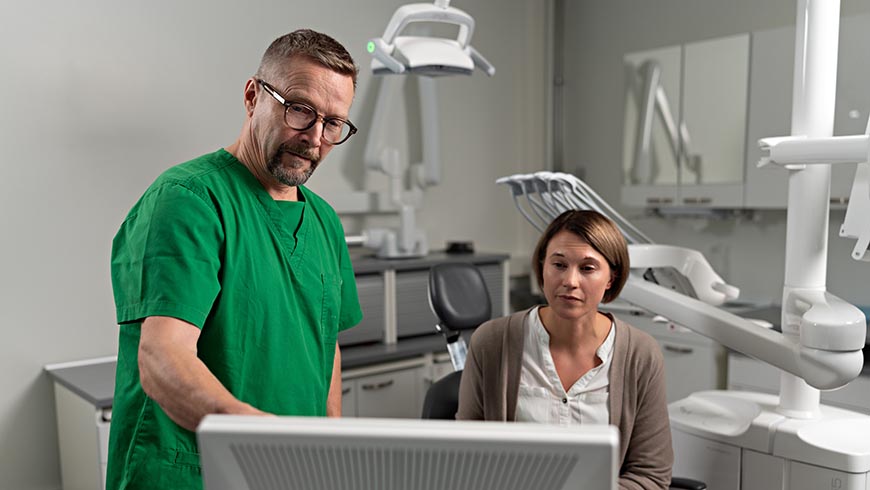
Dental prostheses are used to replace missing teeth. The prostheses may be either removable or permanently fixed. Bridges, crowns and veneer crowns are types of fixed prostheses. They are fixed to your own teeth or artificial dental roots, also known as implants.
Book an appointment for a dental check-up
The material used for fixed prostheses is typically all-ceramic or a metal-ceramic alloy. The teeth will look natural and they are easy to clean.
Dental prostheses can also be used to improve worn occlusion and restore the posture of your face. A stained or twisted tooth that may be cosmetically disturbing can be fixed with a prosthesis, resulting in a tooth that is similar in colour and shape to the adjacent teeth.
When should dental prostheses be considered?
A prosthesis is necessary if you have any missing teeth that make your occlusion imbalanced, weak or inadequate. A prosthesis can be prepared if your tooth is in such poor condition that it cannot be retained. Prosthodontics can also be applied to fix malpositioned and discoloured teeth.
Fixed prostheses: veneers, dental crowns and dental bridges
Veneers, crowns and bridges look natural, they are durable and function just like your own teeth. A crown is a type of dental laminate restoration that covers all of the surfaces of your tooth, including the surface that is visible when you smile. The porcelain, which is used as the surface material, enables the translucence of the tooth enamel and the natural refraction of light.
A dental bridge is a prosthesis in which several crowns are linked to each other. The bridge is fixed to the dental abutments with a material called dental cement. If the bridge is fixed to implants, screws are used. Fixed dental prostheses require careful cleaning. It is recommended to let a dentist check the prostheses annually, just like with your own teeth.
Book an appointment for a dental check-up
Removable prostheses: acrylic partial prostheses and complete prostheses
Removable prostheses are supported by the mucosa of the mouth and, in most cases, fixed to the teeth with metal hooks. The hooks do not damage your own teeth. Partial prostheses can be entirely acrylic or include a metal frame. The teeth are made from plastic. Acrylic partial prostheses are a suitable option if more than one tooth is missing. More teeth can be added to the prosthesis later on.
A complete prosthesis is required if all of your own teeth have been extracted. Complete prostheses are acrylic. They are fixed to the upper jaw with a vacuum between the palate and the prosthesis. Lower-jaw prostheses are fixed to their position according to the shape of the mouth and tongue. The fixation of complete prostheses can be improved with implants, if necessary.
Cleaning removable prostheses
Removable prostheses must be brushed carefully every morning and evening and removed from the mouth before brushing. It is important to brush the prosthesis as acryl is a porous material and bacteria attach themselves to the surface of the prosthesis just like in the case of natural teeth. You can wear the prosthesis at any other time of the day, even when you are sleeping.
Repairing removable prostheses
Carefully cleaned prostheses can last for years. They must be rebased regularly, however. Rebasing is a process in which the base of the prosthesis is re-shaped to fit the mouth. Rebasing is required as the shape of your mouth continues to develop as you get older. Bone and soft tissue become significantly smaller in the two years after tooth extraction. If your prosthesis feels loose, you should check whether it needs rebasing. The attachment hooks of the prosthesis can also become loose over time, and it may be necessary to tighten them.
It is important that complete prostheses are exactly of the correct size and shape and that there are no issues with the prostheses of the upper and lower jaw. This helps the prostheses to retain their position and maintain your occlusion in good shape. Even if you do not have any natural teeth left, you should visit a dentist to check your oral mucosa every couple of years.
Book an appointment for a dental check-up
Expert: Eija Heikelä, dental specialist in prosthodontics and occlusal rehabilitation.